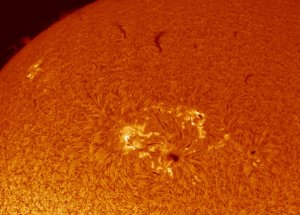
The Sun is our Star, and as you would expect, our Star is hot, bright, dynamic, and sometimes quite violent.
At 93 million miles away, we are ideally placed at a point where the Sun provides just enough warmth and energy essential to our living planet, Earth.
At only 93 million miles, the Sun is close enough for us to view it’s surface thru a relatively inexpensive scope from the comfort and relative safety (Sunscreen please) of our backyards on a clear and warm day.
What! Astronomy during the day? Lunt Solar can show you how.
To a growing many, daytime observing is the only time they can see a Star. To teachers it’s an ideal way to bring the science of a living Star to school kids, and to parents the exploration of the Sun shared with their own children. No more staying up until 2AM in the pitch black and potential cold to visually view pinpoints of light.
What’s more fun than looking at that fireball at the center of our own Solar System?
For the thousands of people who already own a Solar Telescope you’ve already had a hands on appreciation of the dynamic nature of the Sun’s daily cycles.
Given that the hobby of Solar observing really didn’t become mainstream until the late 1990’s, relatively few have probably witnessed the ferocity of a Solar Maximum.
For those that began the hobby in the last few years, you may be wondering what all the fuss is about.
The Sun has been at a slightly extended Solar Minimum of about 1-2 years. This is a time of reduced Sunspot and Flare activity. Being a living Star, the Sun’s activity “breathes” in and out over a period of about 12 or so years.
The Sun has been holding its breath.
For those that are interested, Solar Minimum is now over, and the next Solar Maximum has already begun. Getting a Solar Telescope delivered by Spring maybe just in time.
The Sun has begun to let its “breath” out. As it does so over the next few years, the Sun will become far more active. There are already daily signs of increased Solar activity. My daily observations compared to 1 year ago clearly indicate an increase in daily Sunspot count, Prominence activity, the appearance of Filaments on the surface, Active Regions, and even the rare Mass Ejection.
So how do you see the Sun?
Although the core technology, or the Etalon, of Solar Telescopes has not changed over the last century, the idea of actually looking at the Sun didn’t catch on in the mainstream until the late 1990’s. Before that time, Solar observing was left to the “professional” elite who paid out 10s of thousands of dollars for the precision optical systems required.
Over the last 15 years, the price of a Solar Telescopes has dropped to a point where the “amateur” can make the choice between a good nighttime scope, or a great daytime scope. Even today’s basic Solar Scopes are by far the most advanced ever made.
With entry level Solar Telescopes at $600, and the well fitted LS60T/PT at $1400, the ability to enter the rapidly growing hobby can be achieved by many, and before we make a comparison to that nighttime scope, lets not forget that the LS60T contains 17 precision aligned filters and optical elements that provide redundant 100% safety allowing us to view the Hydrogen-alpha emmision line (ionized Hydrogen) at a bandwidth of less than 0.7 Angstroms (the spectrum is 7,000 Angstroms wide), while reducing all other wavelengths to absolute zero.
That night time scope has 2, maybe 3 lenses/mirrors.
Clubs and events are popping up everywhere. Solar viewing events are being paired with nature viewing events like hiking and birding.
Many cities have yearly science expos where Solar vendors are now showing and discussing the latest equipment, technology, and current solar events.
Solar forums are growing. People are learning to image the sun quickly and easily with simple camera equipment, while others sketch what they see visually.
Education and learning thru hands on observing.
Over the next few months and year, we will be working on promoting the Solar Community thru our new web magazine at www.luntsolarsystems.com. Providing education not only on the use of our Solar Telescopes and Equipment, but also the education of the science of the Sun itself and its effects on our planet.